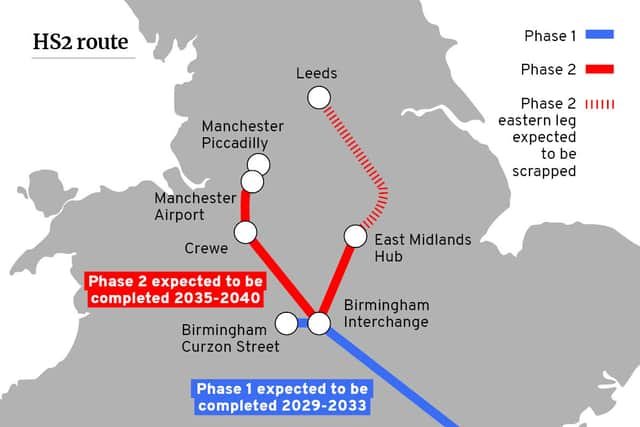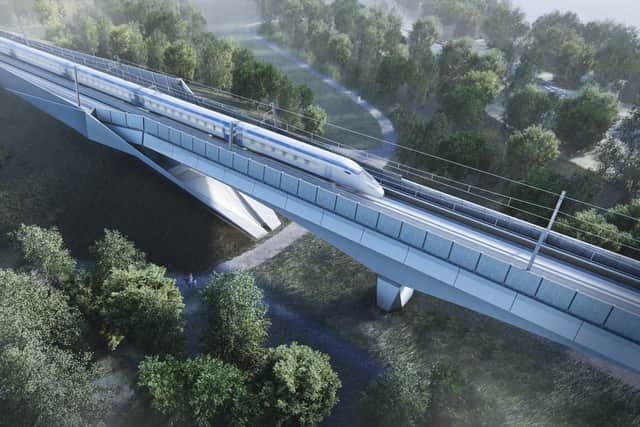HS2 route map: where will high speed railway go - and why has East Midlands to Leeds line been scrapped?
and live on Freeview channel 276
A new rail strategy from the Department for Transport has thrown fresh scrutiny onto the controversial HS2 route through England.
HS2 was designed to provide a high-speed rail link between London, the Midlands and the north of England.
Advertisement
Hide AdAdvertisement
Hide AdPlans for the massive infrastructure project were announced in 2009 and construction on the first phase got underway in 2017.
The scheme is being built in three stages. Phase 1 is expected to be complete and in use some time between 2029 and 2033.
Phase 2A is being worked on at the same time as Phase 1 and services are expected to begin running along this section by 2033.
Work has not yet begun on phase 2B, which includes the proposed eastern leg, and no timescale has been set for its completion.
Advertisement
Hide AdAdvertisement
Hide AdWhat is the HS2 route?
The overall route for HS2 will run from London to Manchester via Birmingham.
Phase 1 will see 140 miles of new dedicated track laid between London Euston and a brand new Curzon Street station in Birmingham.
A “super-hub” will be built at Old Oak Common to the west of London which will link Euston with the northern route of the HS2 line.
From there, the line runs through Buckinghamshire and along part of the former Great Central Main Line route into Oxfordshire. After crossing the A43 in Oxfordshire the line will pass through South Northamptonshire and Warwickshire on its way to the new Birmingham Interchange just south of Solihull.
Advertisement
Hide AdAdvertisement
Hide AdFrom the interchange the HS2 line continues to the purpose-built Curzon Street station in Birmingham city centre.


Phase 2A will carry the line from Birmingham Curzon Street through Staffordshire to Crewe, passing north-east of Stafford and south-west of Stoke-on-Trent.
From Crewe, HS2 services will link up with the existing network for routes to Liverpool, Manchester, Preston, Carlisle, Glasgow, and North Wales.
Phase 2B was initially split into western and eastern legs but part of the eastern leg has now been scrapped.
Advertisement
Hide AdAdvertisement
Hide AdThe western leg will extend from Crewe to Manchester, crossing the M6 on its way through Cheshire. The line will stop at an upgraded station at Manchester Airport before completing its route at dedicated new platforms in Manchester Piccadilly.


To the east, a high-speed link will continue to a new East Midlands hub, where routes will then join up with the existing network.
Why has the eastern leg of HS2 been scrapped?
Following months of speculation, the Transport Secretary Grant Shapps has confirmed that the original plan for the eastern leg of HS2 has been abandoned.
The final element of Phase 2B should have seen a new high-speed link running north-east from Birmingham to Sheffield and Leeds via a new East Midlands Hub.
Advertisement
Hide AdAdvertisement
Hide AdHowever, under the Integrated Rail Plan, the spur beyond the new hub has been scrapped. Instead, HS2 trains are expected to run along existing lines from Birmingham to Sheffield.
Mr Shapps said the original HS2 plans were drawn up in isolation from the rest of the transport network and that the changes to the route improved on the “outdated” original scheme.
He said that the lines to Manchester and the east Midlands, combined with investment in the Northern Powerhouse route, would provide the best and quickest improvement for northern parts of England.
However, critics have suggested the move is simply an effort to cut the spiralling cost of the project at the expense of northern cities and accused the Transport Secretary of “selling out” northern residents and businesses.
Comment Guidelines
National World encourages reader discussion on our stories. User feedback, insights and back-and-forth exchanges add a rich layer of context to reporting. Please review our Community Guidelines before commenting.
